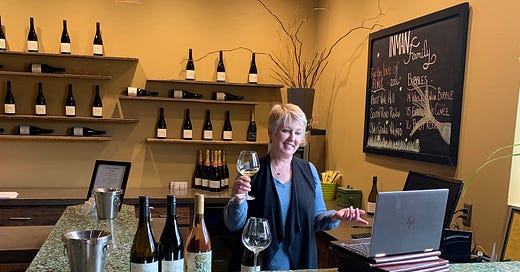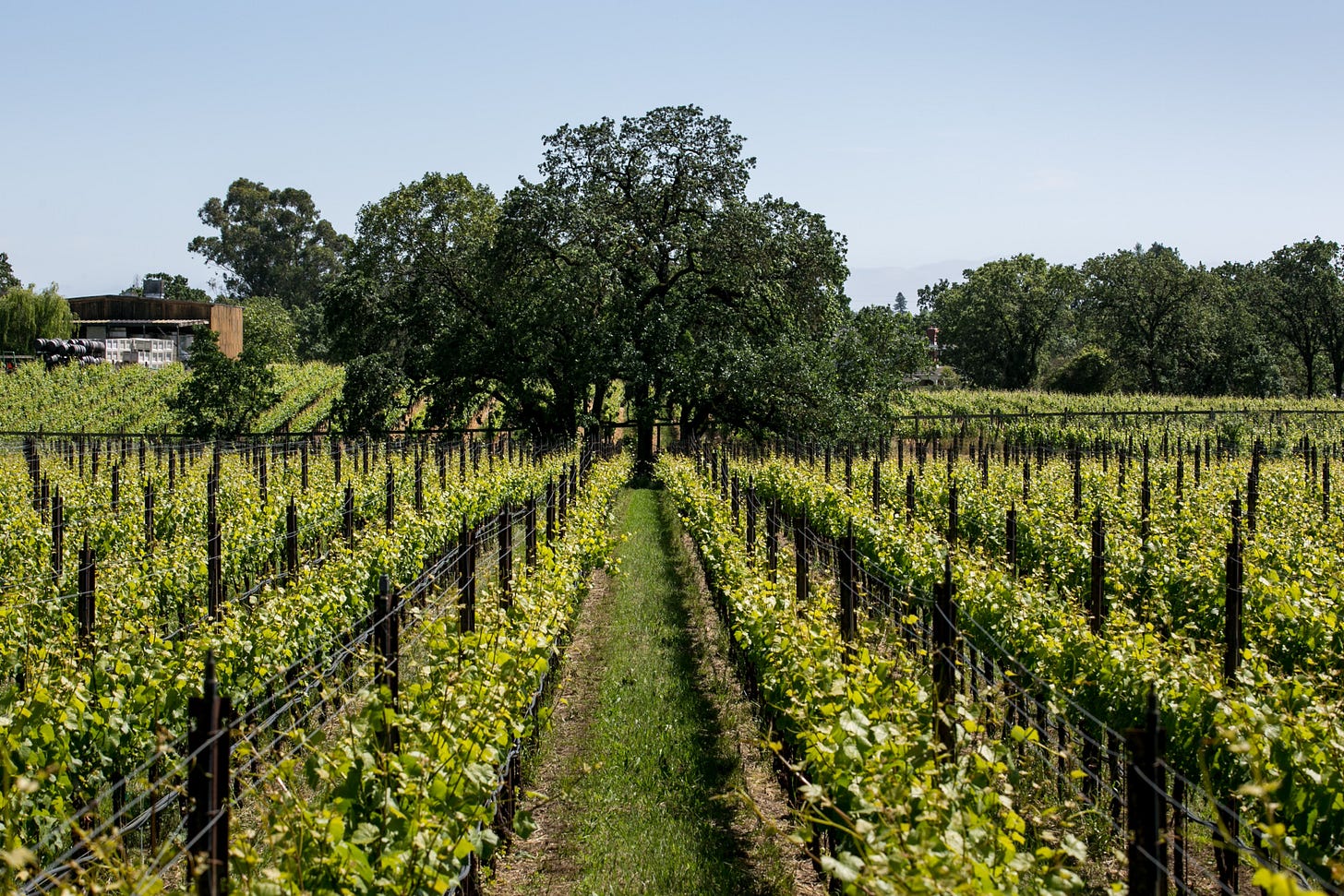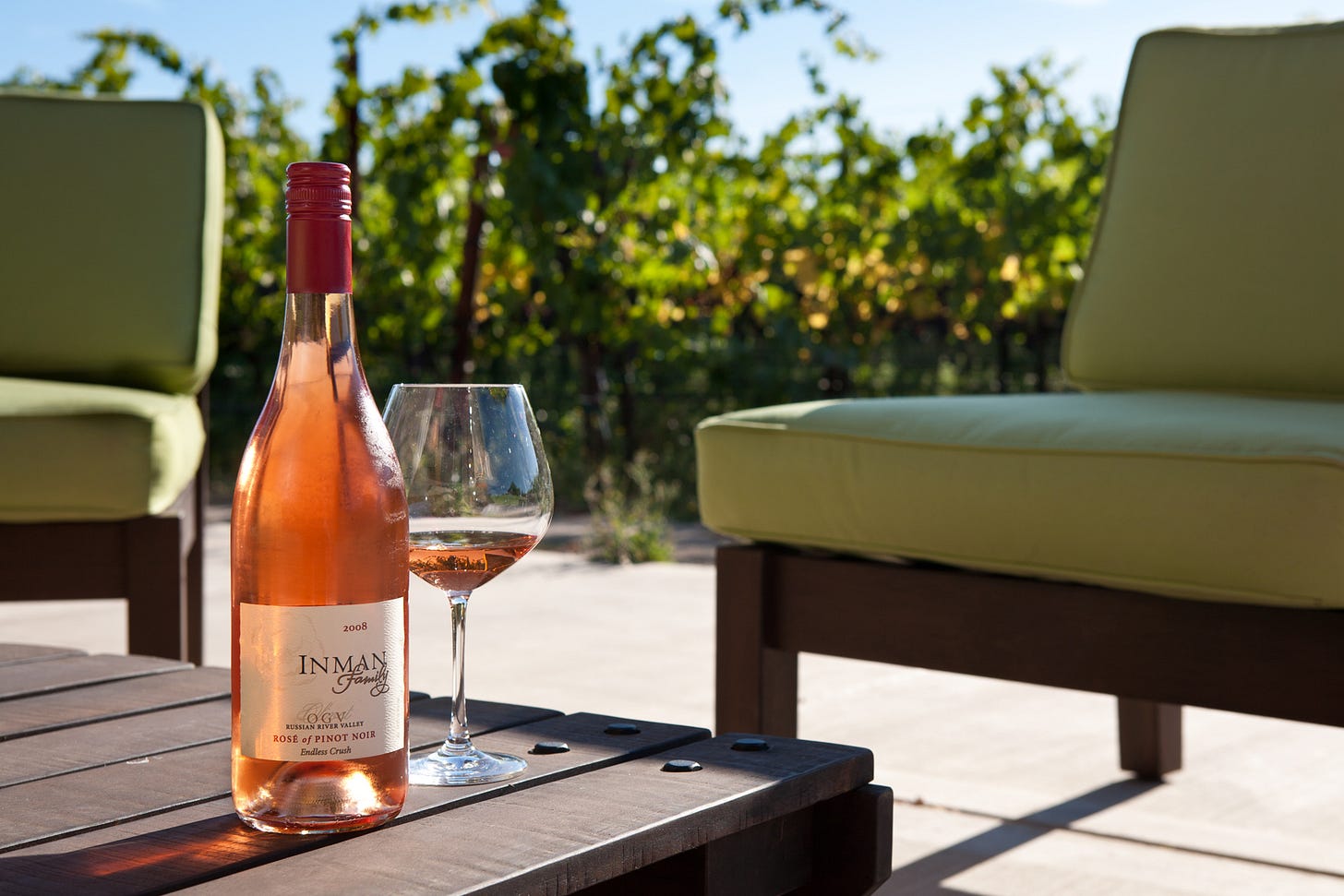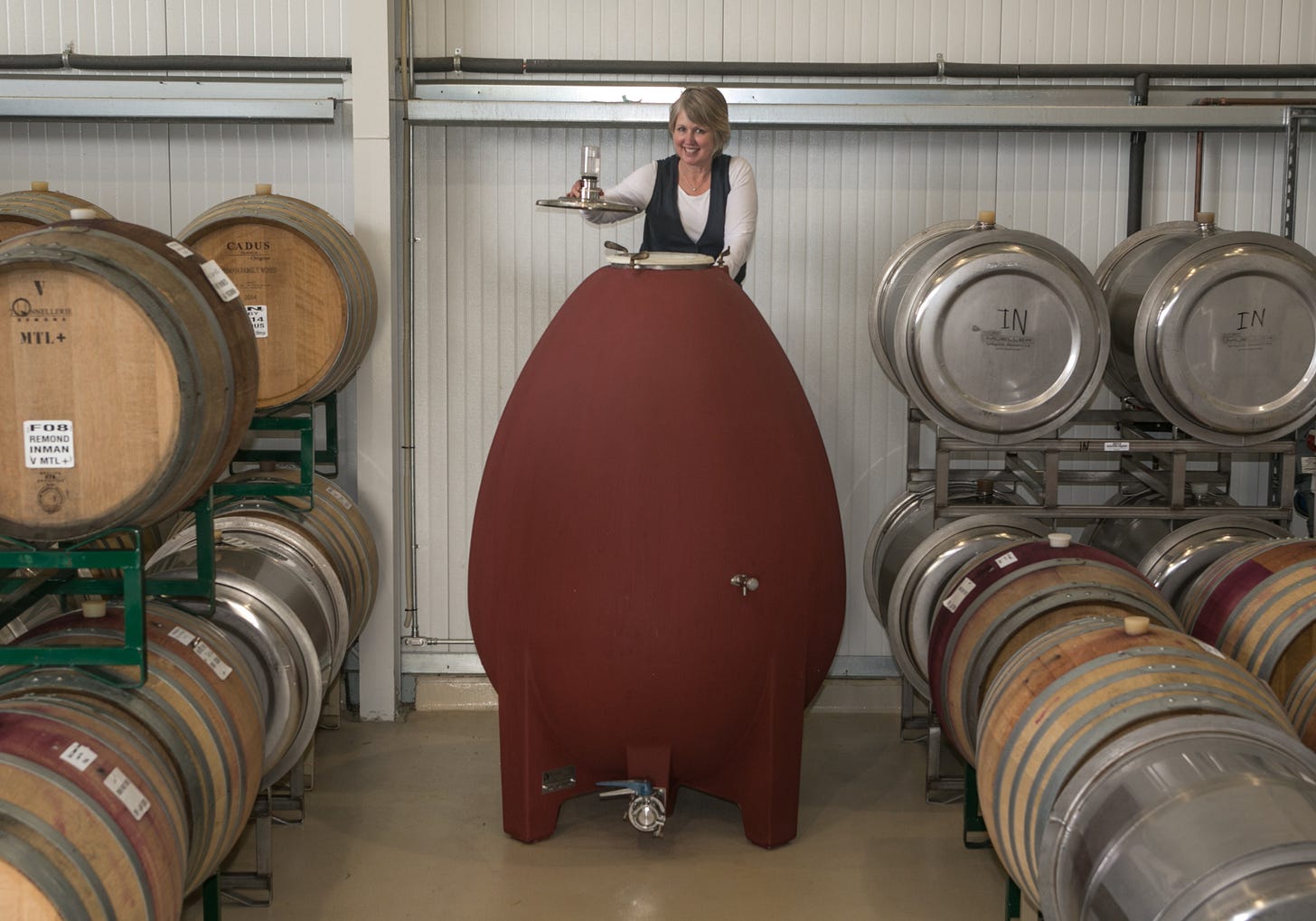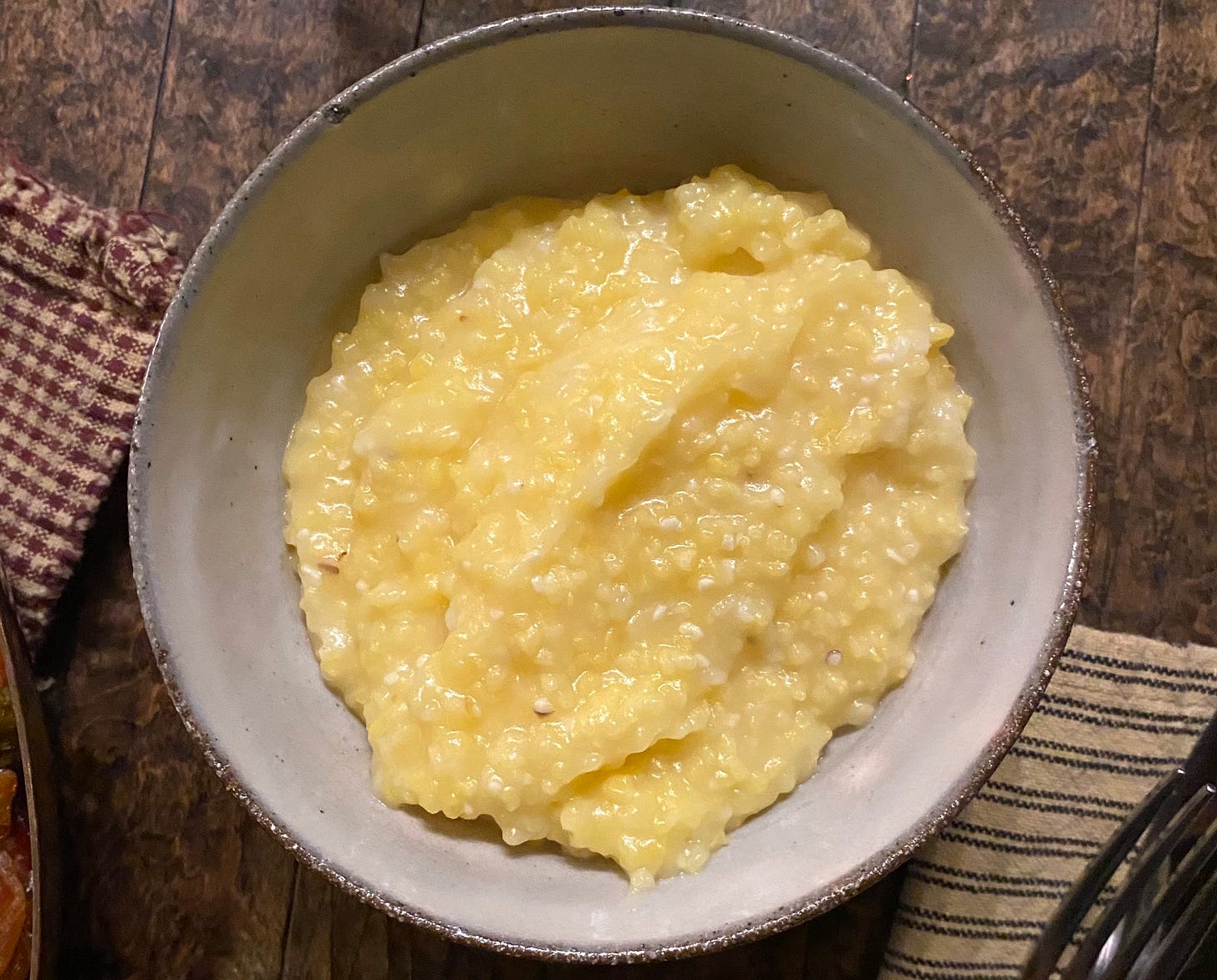Kathleen Inman makes great wine, intentionally
From “eco-ethics” to “sensitive farming” practices, not much of what this Sonoma Pinot Noir whisperer does fits on a label.
Kathleen Inman, the owner and winemaker of Inman Family Wines and Olivet Grange Vineyard in Sonoma County, was lauded for her California rosé long before pink wine became a trendy brunch staple. One reason Endless Crush has structure and acidity, she told me, is because it’s an “intentional rosé.”
Despite my initial assumption, the phrase is not the name of a Goop retreat happy hour. In fact, it’s a serious term, I learned, for a winemaking process that sets Inman’s method apart from other rosés essentially made as a byproduct of red wine. (If you’ve ever had a crisp, complex Provencal rosé, you can imagine what “intentional” tastes like. It’s the process used there.)
And as I got to know Inman over Zoom, the distinction seemed like a metaphor for her entire approach to growing grapes and making wine. All of the terms she’s landed on to describe what she does—like “sensitive farming” and “eco-ethics”—feel like imperfect attempts at naming bits and pieces of a consistent thoughtfulness that is not easily captured by buzzwords.
Inman grew up in the Napa Valley in a family that didn’t drink alcohol. She wanted to get away from the “small town” to work on ambitious career goals, and she worked in England as a headhunter after getting an MBA in corporate finance. A desire to slow down drew her back to Northern California, where the interest in wine she developed in college converged with a penchant for growing things and business acumen, and eventually led to success in a male-dominated profession.
A recent survey found women now make up 14 percent of winemakers in California; for years, that number was stuck at around ten. “There is a lot of machismo in the cellars,” she said, “and there is still an assumption that I have someone else making the wines for me. If my husband is with me at an event, the technical questions always go to him; there's an assumption that it's him.” At this point, they laugh it off, she says. Her husband jokingly introduces himself as her “trophy husband” to counter the stereotype.
Inman embraces complexity while farming, fermenting, and bottling and is also fundamentally practical. She can talk your ear off about her chemical-free pest control methods and compost teas but her wines aren’t certified organic for a few simple reasons. She sometimes makes wild, funky natural wines but is quick to tell you two specific practices she uses don’t fit into the French standard. As she moved her laptop around the winery’s tasting room to show me the recycled wine bottles used to make the bar and the original barn wood that was saved and turned into cabinets, she rattled off a list of environmental features—solar panels that power most of the operation, electric forklifts, recycled wastewater, eco-insulation...but said she threw out her initial plan to get LEED certified when she found out how much it cost. Instead, “I just tried to, you know, do a lot of different things,” she said.
Talking to Inman reminded me of one of the foundational reasons I started Peeled: A lot of stories about food, health, and the environment (yes, I’m calling wine a food here, because in this context, it’s no different than a loaf of sourdough or a hunk of cheddar) aim to provide easy answers. Just buy organic. Use a reusable bag. But while you can and should demand and expect answers about how your food is produced, if you really want the truth, you should also expect those answers to be complicated.
It’s more interesting that way, anyway—especially if you’ve got a glass of Pinot in hand.
(This interview has been edited for length and clarity.)
Why did you start making wine? My husband and I basically had this harebrained idea that we should give up our careers and move to California. We were having this holiday there in 1997 where we basically discussed: Maybe we should look at spending more time with our family, because we both had very busy careers and we had two young girls. Various things happened, and we decided we would do this. My initial plan was just to grow grapes, because I was a really keen gardener. We had about 11 acres in England. I had big organic vegetable gardens, and I also raised cows and sheep on one of our meadows. And so I thought, “Well, I think I can handle the grape growing.” But once we got here, I thought, “I could make wine.” So I decided that I would sell some grapes the first few years, but I made a little bit to see what it was like. And surprisingly, it turned out really well, and I just kind of grew it from there. I stopped selling grapes to other people. In 2006, I started adding other vineyards to my winery. It’s been much more of an evolution than an epiphany. And Pinot was one of the first grapes that I really fell in love with.
What makes you so passionate about Pinot Noir, specifically? I think what I love about it most is that it makes absolutely delicious sparkling wine, and I am a fiend for sparkling wine. It makes absolutely delicious rosé, and I'm very passionate about rosé. And then when it's made as a red wine, it expresses the place that it's grown in a way that I think is intellectually really interesting. A lot of other grapes are much more fruit primary, and over time they change, whereas Pinot is sort of savory from the beginning. It isn't just getting that umami character as it ages, it’s got that very early on, and…the floral, the black tea, the herbal things. It's got everything. I like its flexibility, and I love that it's got different personalities.
You say you practice “natural winemaking,” which as you know has gained so much momentum and popularity over the last few years. Did you always make wine this way? In the beginning, my goal was to grow my grapes organically. That's how I did my gardening in England. I had my own compost, and I had a worm farm and worm teas. So that part was always there. For the wines, when I first started, I was afraid of ruining things by using the practices I wanted to. I remember I picked very early in 2003, the very first Pinot vintage. I wanted to pick early so that I’d have a nice, natural acidity. I didn't want to have to add anything or take anything away. And I remember being terribly worried that I made a huge, huge mistake because my wine tasted like forest floor and all the things that it tastes like when you start early. And I was like, “Oh, my God, it’s going to be terrible.” But it ended up being a really lovely vintage and just what I wanted. I wasn't adding any enzymes or tannins, even though people were telling me to. But it wasn't until after 2006 that I started doing all wild fermentation. Then I kept it pretty much that way ever since, and I've done some crazier things, like my 100 percent whole cluster Pinots that are carbonic macerations. I just leave the stuff for 30 days and let it do its own thing. But there are two steps that I use that are not 100 percent in the French definition of natural winemaking.
What are they? One of them is the addition of sulfur dioxide. When grapes come into my cellar, I don't add any at all, and I wait until quite a long time after ML [malolactic fermentation] is finished in most of the wines to add any. Basically, if the wine is not showing any volatile acidity changes, then I just leave it. I don't need very much sulfur when I bottle either. But it isn't 100 percent natural because I am adding sulfur. The last thing I do is I filter the wine. I do that because I like the clarity of filtering. But also, I'm making these wines with all the wild yeast and bacteria, and there are good guys and bad guys in there. And once I put it in the bottle, I don't want it to change. And so very crudely, I jokingly say that it's like safe sex. You may not want to do it, but the consequences of not doing it can actually be fatal—for the wine.
So what you do doesn’t completely qualify as natural wine, but what about organic? Why don’t you or the many other natural winemakers who are using organic fruit get certified? In the US, you can only have 10 parts per million of [naturally-occuring] sulfur dioxide to be organic. When a fermentation happens, you have almost that amount just from the natural process. Some grapes through that process produce more sulfur. Syrah does, for example, and so you could be over the limit without having put it in. Or if you use organic sulfur in the vineyard to stop powdery mildew, like I do, and there's some on the grapes when it comes into the cellar, that's in the juice. That's one of the main things that makes it harder...and you have to pay for the certification.
Right, and the cost is worth it for a lot of organic farmers because people will pay more for organic vegetables, but that’s not really true with wine, is it? People don’t look for organic? When I first started, I would be standing at my table doing tastings at events, and I'd say, “These grapes are from my estate that I farm organically.” And people would say “Oh, this is really good for organic wine.” No one says, “Oh, you know, these tomatoes taste really good for organic.” And I think bad organic wines have made that a thing. So I just call it “sensitive farming.” It could be certified if I really wanted it to be, but I'm doing it because it's the right thing to do for the environment. My grapes are healthier, and it's better for everybody who lives around the vineyard and the animals.
Speaking of the environment, have you been affected by the wildfires over the past few years? The fire last August came 2.3 miles from me, right where I'm looking straight in that direction, and then the one in 2017 was 2.5 miles in that direction. So, definitely very close, and I had to evacuate my home several times. This year, this past vintage, I had to reject just about half of the fruit that I normally work with. The estate vineyard was fine, but the other vineyards had smoke taint in the fruit. So usually I make somewhere between 3800 and 4800 cases, and I only have 2200 in the cellar. My break-even is at 3800, so it's gonna be a problem when that vintage comes to market.
Is there anything you can do to prepare or protect the vineyard and winery from future fires? Well, vineyards are pretty much firebreaks. The reason that the fire stopped when it came on this side was it hit vineyards, and it kind of singed the edge of the vineyard. It's the dry grasses and trees that are damaged from drought that have fueled these wildfires. But there's not really anything we can do. I am glad that I have 16,000 gallons of wastewater storage on site, because I reprocess all my wastewater.
That’s one of the many things you’ve installed to decrease the winery’s environmental footprint. What are some of the other big things you do differently? When I built the winery, there was an old barn on the site, and I took that barn down and saved all of the wood, and we reused it in making the new building. So it’s in the porch and the shelves and cupboards you see behind me. And we're all solar powered here. Everything runs on electric. I don't use any propane or diesel. My forklift is electric, water is electric. And I don't use very much hot water. I use steam, which uses less water to get the same sanitizing effect. The windows are the low-e ones, the walls are R30 and the ceilings are R38, so highly insulated. And the south-facing side has additional insulation made of recycled jeans and other fabrics.
All the packaging we use for shipping is compostable and predominantly made of recycled pulp. With my glass, I've tried over the years to focus on domestic bottles that are lighter weight. I've never gone for that big, hunky bottle size where people pick it up and think, “This is an expensive wine. Feel the weight of the bottle!” I've chosen smaller bottles because they're lighter to ship, so less energy is used to get them out. And since I'm a direct-to-consumer business, that's very important.
The average wine drinker isn’t going to have access to details like these about every winemaker. How do you suggest people choose wines if they care about things like environmental impacts? I think it's very hard. I get asked this question a lot when I'm doing my virtual tastings. The only thing I've come up with is doing research and also speaking to people who are knowledgeable. It's kind of like networking. It's about asking questions of the people who know, and if they say they don’t know anything about it, then I think you have to do the research.
A side of policy
How will the new stimulus package impact the food system? President Biden is expected to sign the most massive COVID-19 relief bill of all this week, and it includes provisions to aid food insecure families, Black farmers, and struggling restaurants. The Counter breaks down some of the biggest food and farm provisions, here, including a $29 billion fund that will give grants to restaurants (especially small ones) that have suffered losses, an extension of both increases to SNAP benefits and the P-EBT program, and $4 billion in debt relief for Black farmers, who have long struggled to access USDA programs due to discrimination.
Still hungry?
Speaking of COVID-related federal food programs…For FoodPrint, I reported on how small farms and local food hubs thrived in the Farmers to Families Food Box Program (which is likely to continue in some form with additional funding from the stimulus) until USDA changed the rules, and whether takeways from recent analyses point to the fact that local, fresh food producers should play a bigger role in emergency food relief in the future.
Big wild things! Earlier this week, Biden swung by Little Wild Things Farm for a visit. In 2019, I had founder-farmer Mary Ackley on The Farm Report to talk about growing microgreens and edible flowers in Washington, D.C., so I thought I’d resurface the interview in case, like POTUS, you’re curious. Here’s the link on Apple Podcasts, but you can search for The Farm Report, Episode 371, “Growing Little Wild Things,” wherever you listen to podcasts.
Actually eating
I didn’t really encounter grits much growing up in New York, but when I moved South and discovered how delicious, affordable, and versatile they are, that changed. Now they’re a kitchen staple. I make them as a side dish with chicken or fish or as the base of a vegetarian meal, with roasted vegetables thrown on top, for example. All you really have to do is boil, stir, and add butter. (Grits have indigenous roots and a long history in Southern cuisine that others much more knowledgeable than me have covered.)
We get ours in bulk from an Amish farmer in Pennsylvania but you can get them at most natural-leaning grocery stores, often in bulk bins. I also really like these purple rice grits from a Florida farm, and Anson Mills sells varieties made from all different kinds of corn in 10-pound bags.
Let’s be friends
Follow me on Twitter and Instagram to continue the conversation. See you next week!

